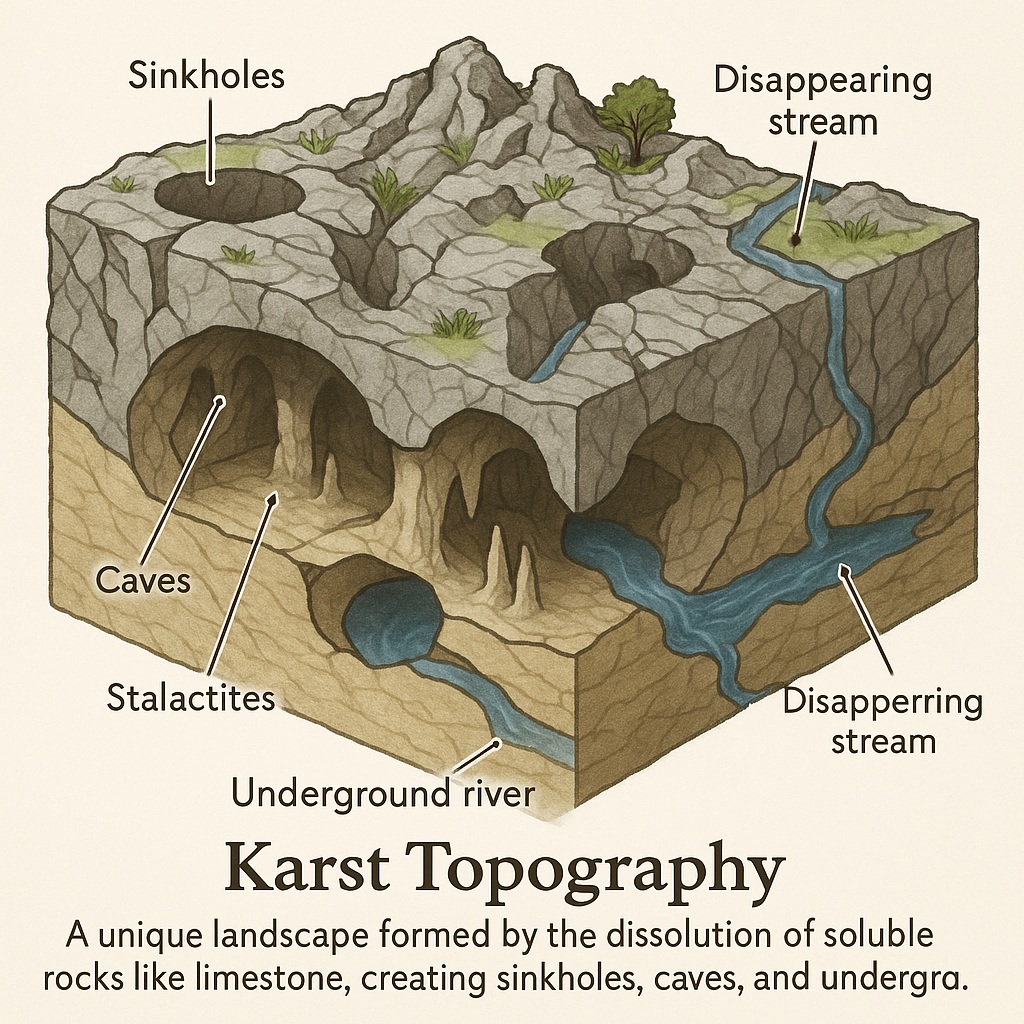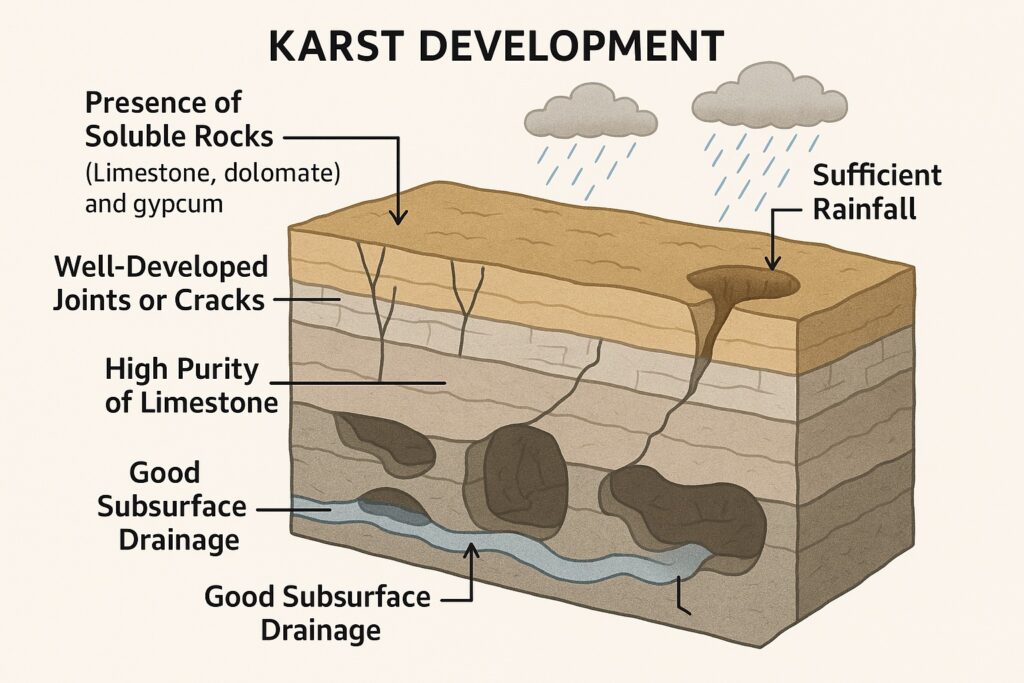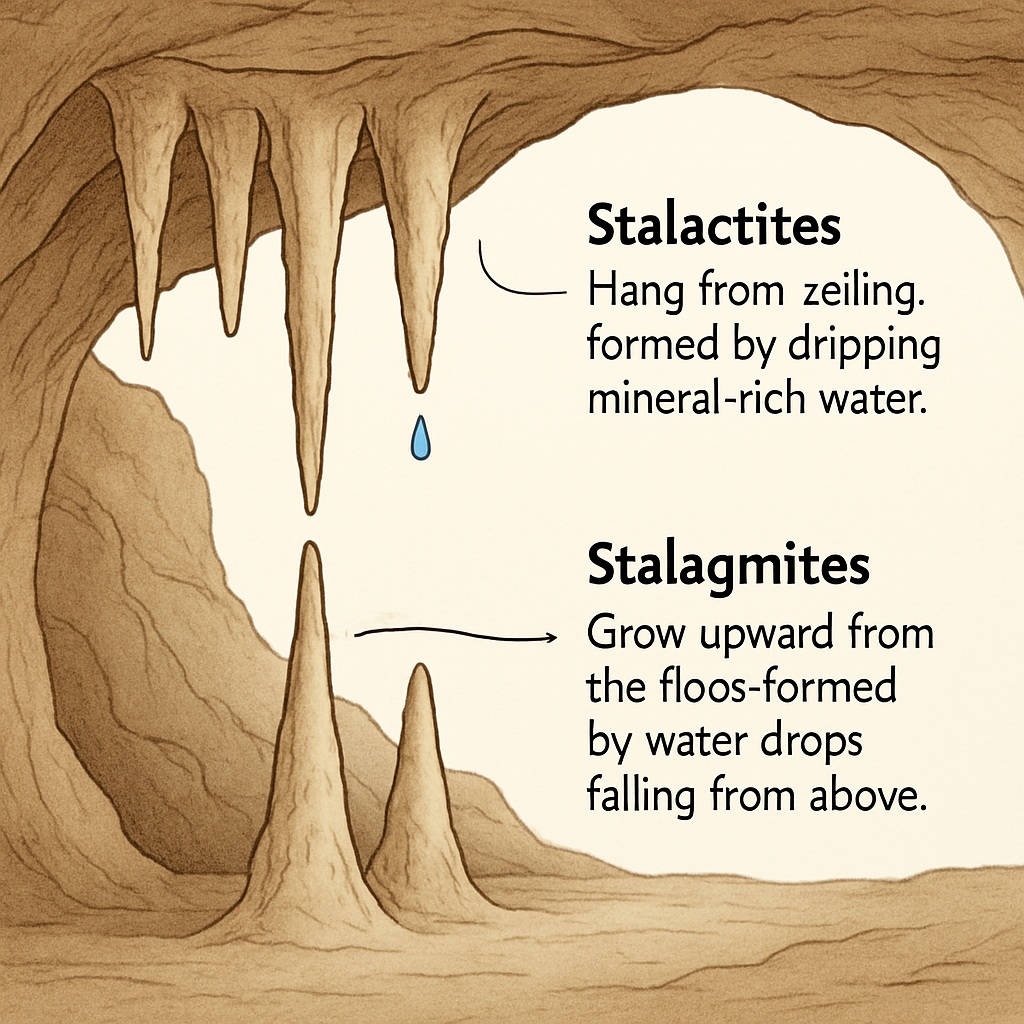Karst topography is a unique type of geological formation that develops in regions with soluble rocks, such as limestone, gypsum, and dolomite. It is characterized by distinctive surface features, including sinkholes, caves, underground rivers, disappearing streams, and rugged terrains with irregular and jagged landforms. Karst landscapes are created primarily through the process of chemical weathering and erosion caused by the dissolution of soluble rocks by water.

Table of Contents
What Is Karst Topography?
The term karst originates from the Kras region of Slovenia and northeastern Italy, where such landforms are prominently displayed. Karst topography develops in areas where chemical weathering, especially carbonation, acts intensively on carbonate rock.
When rainwater, which is naturally acidic due to dissolved carbon dioxide (forming weak carbonic acid), seeps into the ground, it reacts with the calcium carbonate (CaCO₃) in limestone, forming calcium bicarbonate (Ca(HCO₃)₂) — a soluble substance that gets carried away in solution. This process gradually creates underground voids and characteristic surface features.
Conditions Necessary for Karst Development
-
Presence of Soluble Rocks: Predominantly limestone, but also dolomite and gypsum.
-
Well-Developed Joints or Cracks: Facilitate the percolation of water.
-
Sufficient Rainfall: Ensures availability of acidic water for dissolution.
-
High Purity of Limestone: Pure limestone is more prone to chemical weathering.
-
Good Subsurface Drainage: Promotes underground water movement and cave formation.

Key Features and Processes of Karst Topography
Soluble Rocks
Karst topography forms in regions where the underlying bedrock consists of soluble rocks, particularly limestone (calcium carbonate) and dolomite (calcium magnesium carbonate). These rocks are easily dissolved by slightly acidic water, particularly rainwater that absorbs carbon dioxide from the atmosphere and becomes weakly acidic.
Carbonic Acid Dissolution
Rainwater containing carbon dioxide (CO2) forms carbonic acid (H2CO3) when it interacts with the carbonate rocks. This weak acid reacts with the minerals in the rocks, gradually dissolving them over time. This process is known as carbonic acid dissolution.
Sinkholes
As the soluble rocks dissolve, voids and cavities form beneath the surface. Over time, the roof of these cavities may collapse, creating depressions in the landscape called sinkholes. Sinkholes can vary in size from small depressions to large sinkholes that can swallow entire buildings.
- Funnel-shaped holes on the ground
- Formed when water dissolves the limestone below
- Can be 3 to 9 meters deep
Caves
As water continues to dissolve the soluble rocks, extensive underground systems of caves and caverns can form. These caves are often adorned with unique formations, such as stalactites and stalagmites, created by the deposition of mineral-rich water.
Disappearing Streams
In karst landscapes, surface streams may suddenly disappear underground when they encounter sinkholes or fissures, reappearing later as underground rivers. This phenomenon is known as a disappearing stream or losing stream.
Karst Springs
Water that percolates through the soluble rocks can emerge at the surface as karst springs. These springs are characterized by a constant flow of water and are often sources of freshwater for human communities.
Tower Karst
In certain regions, karst landscapes can take on unique forms known as tower karst, where residual limestone hills or towers are left standing after the surrounding areas have eroded away.
Karren
Karst surfaces may also develop distinctive textures called karren, which are formed by the dissolution of the rock by rainwater and other forms of weathering. Common karren features include runnels, grikes, and clints.
Subterranean Features
Caves and Caverns
Large underground hollows formed as acidic water dissolves the rock over millennia.
Stalactites and Stalagmites
-
-
Stalactites: Hang from cave ceilings, formed by dripping mineral-rich water.
-
Stalagmites: Grow upward from the floor, formed by water drops falling from the ceiling.

Stalactites and Stalagmite
-
Columns
When stalactites and stalagmites grow enough to connect.
Underground Rivers and Lakes
Extensive drainage systems develop underground, sometimes forming subterranean rivers and reservoirs.
Global Distribution of Karst Regions
Karst topography can be found worldwide, especially in regions with extensive limestone deposits:
-
South China Karst (UNESCO World Heritage Site)
-
Yucatan Peninsula, Mexico
-
Appalachian region, USA
-
Dinaric Alps, Slovenia and Croatia
-
Cherrapunji and Meghalaya Plateau, India
-
Carpathian Basin, Central Europe
Karst Topography in India
India has several prominent karst landscapes, particularly in:
-
Meghalaya (Mawsmai and Siju Caves)
-
Eastern Rajasthan (Ajmer and Udaipur regions)
-
Western Odisha
-
Parts of Andhra Pradesh and Karnataka
These regions feature caves, sinkholes, limestone pavements, and poljes, and are vital for studying Indian geomorphology.
Environmental Concerns in Karst Areas
-
Groundwater Pollution: Due to rapid infiltration and minimal filtration.
-
Sinkhole Hazards: Can cause sudden ground collapse in populated areas.
-
Overuse of Water Resources: Leads to aquifer depletion.
-
Tourism Impact: May lead to degradation of fragile cave ecosystems.
Importance and Challenges
Karst topography has significant ecological, hydrological, and geological importance. It provides essential groundwater resources and plays a crucial role in the formation of unique ecosystems. Karst landscapes are often sought-after tourist destinations due to their stunning caves, sinkholes, and underground rivers.
However, karst landscapes are vulnerable to human activities, such as groundwater extraction, deforestation, and pollution, which can lead to the degradation of these fragile environments. Proper management and conservation are necessary to protect these natural wonders and preserve their ecological significance.
In conclusion, karst topography is a fascinating geological phenomenon characterized by its distinctive features formed through the dissolution of soluble rocks. From caves and sinkholes to disappearing streams and karst springs, these landscapes hold both geological and ecological significance, making them valuable and fragile natural resources that require responsible stewardship and protection.
Read: Geography Notes
